 I had been told before to skip Athens or give it only a day when traveling to Greece.
I had been told before to skip Athens or give it only a day when traveling to Greece.Mijo and I were skeptical about this suggestion and we wanted to give Athens a chance. We were rewarded by our decision and the longer we stayed in the city the more we loved it.
Mijo and I arrived in Athens late in the evening so there was really nothing to do but unpack and chill. The very first thing we did in Greece was sample a refreshing local beer called Alpha. Alpha happens to be the first letter in the Greek alphabet. First for first.
This view of Athens greeted us during our breakfast. The Acropolis and the Parthenon in my plain view! I used to read them in my geography books as a child. The city seems dense and is not flat at all. The morning sun added a flattering orange tint to the cityscape. I couldn't help but imagine how grand the city must have looked like back in the time of Socrates and Plato or even before Greece was a united country.


Our hotel is located south of the Acropolis. We could either walk to the Acropolis or take the public transport via the subway train, the trams or buses but we didn't know yet how the transport works. We decided to walk with the aid of Google map. From the city streets, Athens looks and feels like any modern European city to me. I guess I was expecting to see lots of buildings designed in classical styles with massive Ionic columns. What I saw were mid-rise apartment buildings and shops and restaurants and cafes.
After about 20 minutes of walking we reached the Acropolis area where the new Acropolis Museum and the South Slope entrance to the Acropolis are located.
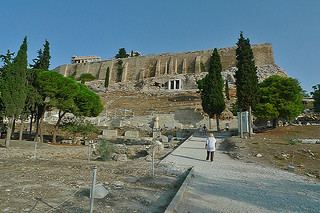
After we got our tickets, we hiked up and saw lots of broken marble statues, columns and small pieces of ancient structures along the way. It is funny how I, along with hundreds other tourists, took pictures of these rubbles as if they were important pieces of a major structure in the Acropolis.
We finally reached the Theatre of Dionysius. Dionysius is the god of plays and wine in Greek mythology. This theatre had been used as a theatre since 6th century BC but had undergone several renovations. It hosted great productions including those of Sophocles and Euriphides. This was the first of the many ruins that I'd be seeing in Greece and I was in awe. In awe of the idea behind the design. In awe of its aesthetics and in awe because they were constructed thousands of years ago.

I was surprised to learn that they let people go inside the theatre and hike up to the highest seating area. The marble slabs are so smooth it can be slippery at times. Just be very careful when hiking up the theatre. The marble planks are cool to the touch even though it was a hot day that day and the sun was upon us.

I was surprised to learn that they let people go inside the theatre and hike up to the highest seating area. The marble slabs are so smooth it can be slippery at times. Just be very careful when hiking up the theatre. The marble planks are cool to the touch even though it was a hot day that day and the sun was upon us.
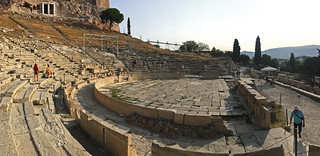
Afterward, we reached the Odeon of Herodes Atticus. We couldn't go inside the theatre because I think it is a functioning theatre. It was completed in 161 AD. By this time, we joined the other tourists who got in the Acropolis through the main entrance so there were swarms of people taking pictures and selfies every where. It was a challenge to get my turn to take this photo. I can imagine this place must be swarming during the peak summer season.
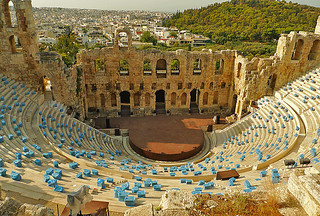
This grand entrance to the Acropolis is called the Propylaea. This is where we rested for a bit and enjoyed the shade and breeze after walking uphill from the South Slope entrance. I was admiring how truly grand this gate must have been. A grand city deserves a grand gate, I thought to myself.

The Acropolis greeted us after we passed through the entrance. Massive structures in ruins. The sun was glaring down at us and not a single tree in sight for a shade. I passed by different groups touring the complex and they are grouped by language. I heard Spanish, Chinese, Japanese and of course, English.
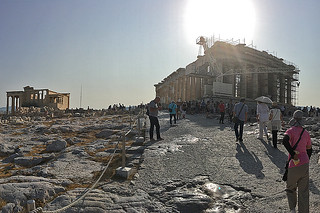
Again, the stones had been smoothed by wear and tear through 2,500 plus years so please be very careful when walking around the Acropolis.
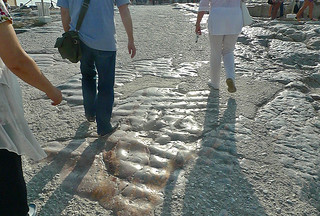
The Parthenon on the left, the Erechtheion on the right. The Parthenon is a temple dedicated to Athena and was completed in 438 BC. The Erechtheion was completed in 406 BC and is a temple dedicated to Athena and Poseidon. Because of Greece's very long history, the chronology of details of Parthenon's construction, destruction and renovation drowned me. Instead of focusing on the details, I wanted this experience to be personal rather than mental. Mijo and I lingered here a bit admiring the Doric and Ionic columns and imagining what these structures and the entire area must have looked like during the zenith of Greece's power. It was an amazing experience seeing these ruins in person.
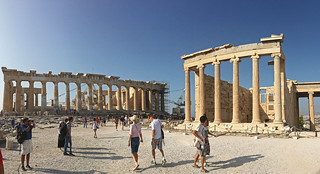




Luckily, I was going to see this miniature version of the Acropolis later that day during our visit to the Ancient Agora. White gleaming marbles everywhere. This gave me a clearer picture of what it looked like. The Acropolis must have been absolutely awe inspiring jaw dropping back then. Its builders were truly great architects, designers and engineers! They built something so great that left a mark in history and made this small town Filipino and many others in awe 2,500 years later.
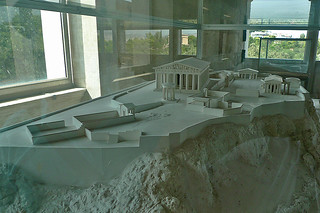
While Mijo waited under a shade, I braved the heat and walked all the way to the other side of Acropolis where a huge Greek flag is located. From there, I got this entire view of the Acropolis. Once again, I lingered here a bit trying to take the view and the 2,500 plus years of its history all in. At this point, I was struck by a feeling of thankfulness and felt a sense of privilege and couldn't believe what I was seeing. Never in my wildest dreams did I imagine I would see this in person.
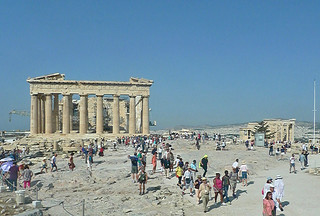
After Acropolis, Mijo and I walked toward the nearby Areopagus Hill, or Mars Hill, from where I found this view of the Ancient Agora which we also visited later that day.
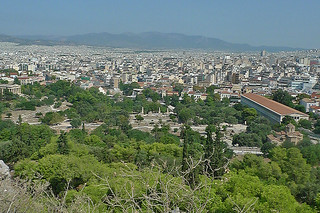
Our combo Acropolis ticket included a pass to go in the Ancient Agora. Agora literally means gathering place. This was the center of spiritual, artistic, and political life of classical Athens. I imagine this place was where the exchange of culture, ideas, beliefs, inventions, innovations happened.
The first Agora ruins that we saw was the Roman Agora.

Afterwards, we reached the main complex of the Agora where the Stoa of Attalos is located. The Stoa was a gift to the city of Athens by King Attalos II of Pergamon who ruled from 159 to 138 BC because of the education he received from the city. Today, the Stoa houses the Museum of Ancient Agora. The museum includes lots of sculptures of busts of Greek gods and patrons and prominent citizens of Athens at the time. The museum also houses excavated objects from the 7th to 5th century BC.
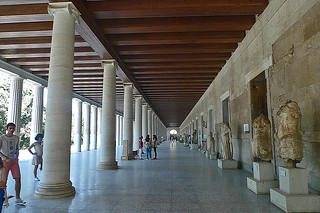



Not far from the Stoa is the most intact ruins that I've seen in Athens called the Temple of Hephaestus. Hephaestus is the god of craftsmen, artisans, carpentry, metallurgy, blacksmiths, etc. He sounds like a god of creativity to me.
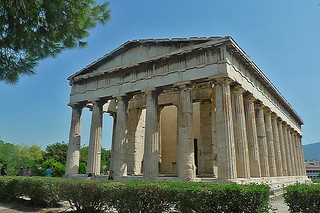
Again, this miniature version of the Ancient Agora allowed my imagination to walk through the streets of this city center which was ground zero for innovation and creativity.
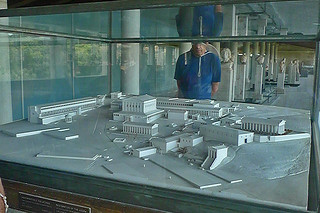
It was already past 2'oclock when we sat down for a good lunch. There is a street next to the Agora called the Souvlaki Row on Adrianou St. where restaurants upon restaurants serving Greek food can be found. We decided to sit down and have lunch at Dia Tafta. Mijo and I shared a very good salad with a big slab of feta cheese and a delicious kebab with very tasty house potatoes. I really enjoyed this lunch considering I was more sleepy, tired and thirsty than hungry at that moment. Afterwards, we had Greek coffee and baklava at a nearby cafe called Kotilli. I was expecting my first Greek coffee to be served in a copperware but it was a great experience nonetheless. Greek coffee, I noticed, has a muddy and sandy consistency very much like an extra thick hot chocolate with coarse chocolate bean bits.




No time to waste so our journey continued to the Eastern part of the ancient city called Hadrian's Arch, or Hadrian's Gate. It was built to honor Emperor Hadrian, the 14th Emperor of the Roman Empire. This complex also includes the ruins of the Temple of Olympian Zeus.
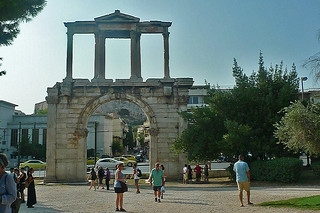
The Temple of Olympian Zeus was dedicated to the god Zeus. Construction started around 6th century BC and finished in 2nd century AD. It once had 104 columns in the Corinthian order and was renowned as the largest temple in Greece.
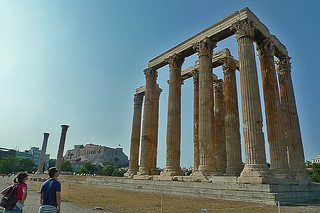


Afterwards, we walked further going north of the old city toward Syntagma Square. We saw a bunch of people gathered in front of the Greek Parliament.
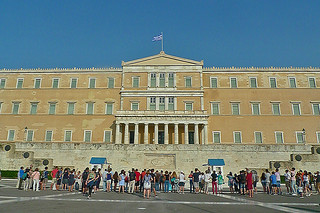
At that moment, the changing of the guards was happening in front of the Tomb of the Unknown Soldier. The slow marching steps of the soldiers under the Greek sun were mesmerizing. I've never seen such intricate soldier uniforms - red beret, pleated sleeves, white kilts, beige tights, pom-pomed legs and clogs. I absolutely love it.
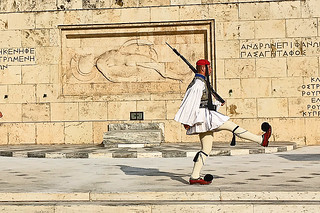
We further walked along Ermou St. and this is where one can witness the modern Athens in action and where to mingle with local Athenians dining and shopping. We passed by the lively Syntagma Square with locals enjoying a nice Sunday afternoon.
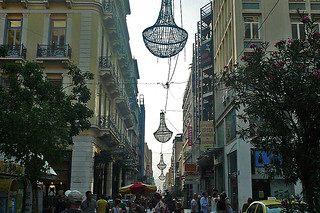


We found this Greek Orthodox church called Panaghia Kapnikarea in the middle of the street.
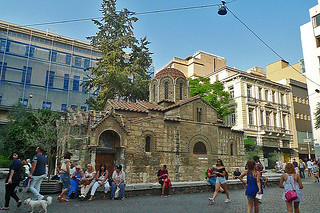
We finally reached a lively area of the city called Monastiraki where locals and tourists converge. Stores, shops, restaurants and flea markets dot the area.
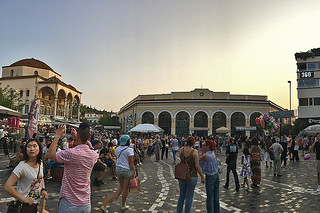
We were not too hungry to eat dinner so we just decided to get something to-go like this very tasty Kebab wrap from Sabas Kebab.


We did have some room for sweets like these ones from Meliartos.
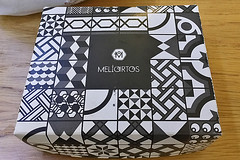
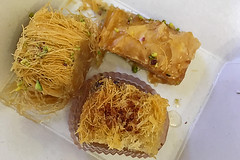
It was also in Monastiraki where we tried for the first time and braved the Athens subway. Because our tired feet couldn't endure anymore walking. From here, we took the Blue line and then transferred to the Red line. It was easy to follow.
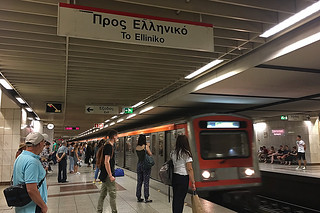
They have ticket machines and kiosks but we bought our first tickets from a friendly station agent who taught us how the train system works. Don't forget to validate your tickets! We were told that the Athens subway is one of the good things that the 2004 Olympics had brought to the city and to its locals.
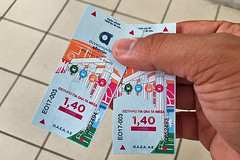
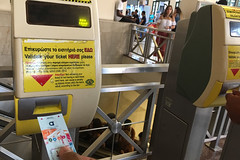

Some of the stations have designated areas for displaying ruins and antiquities that were unearthed during the excavation of the subway tunnels like these ones in Monastariki and Syntagma stations.
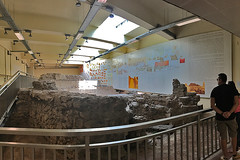
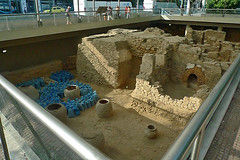
They even set up mini museums to showcase the excavated objects like the ones in Panepistimiou station.
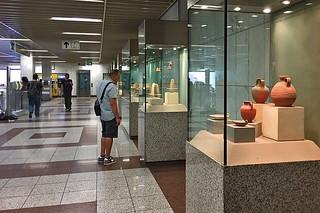

On our second full day in Athens, we were armed with the knowledge and confidence to venture outside of the old part of town. We wanted to explore the area where the National Library, Athens University and Academy of Athens are located and they are all near the Panepistimiou station.
Here are the views of Athens University. We did not go inside but the outside views were beautiful. There are frescoes adorning the walls of the building.
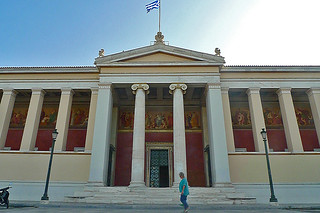
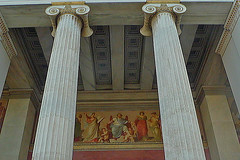

Next is the Academy of Athens building next door. We were told that the actual university is now in a different part of the city and this building had been transformed into a museum.
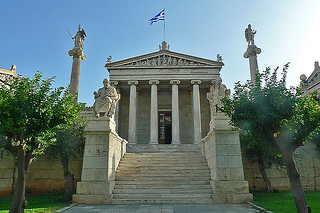



And finally, the National Library.
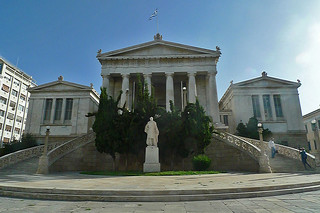
I was able to get inside the library's lobby where they have displays of works by Nikos Kazantzakis, famous author of Zorba the Greek. I was also told that there is a new library location and they are in the process of moving the collections from this old location to the new one.
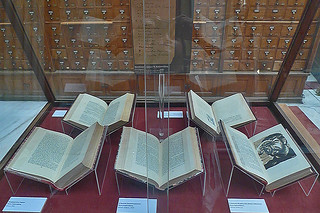



We took the subway's red line to Ominou station and walked a few blocks to see the National Archeological Museum. The collection here is immense. We spent almost half the day inside the museum. It was tough to weed through the countless objects unearthed from different places from various times in Greece's long history. I'll just give you my favorites from each of the different sections of the museum.
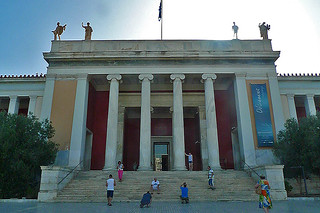
These marble figurines are from the Cycladic Civilization section. The Cycladic civilization existed and flourished in 3200-2800 BC. The Cyclades is a group of islands in the middle of the Aegean Sea. These marble figurines were unearthed from ancient cemeteries in the islands of Melos, Naxos, and Syros.

The golden mask is believed to be the Mask of Agamemnon in the Mycenaean treasure sections from the Middle Helladic period (16th - 15th century BC). These treasure were excavated from an area called Grave circle A in Mycenae discovered by Heinrich Schliemann.
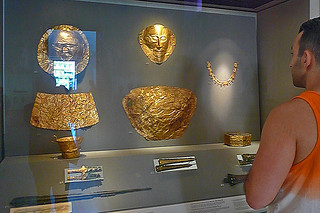
These fragments were part of a fresco that adorned the walls of the Acropolis of Mycenae.
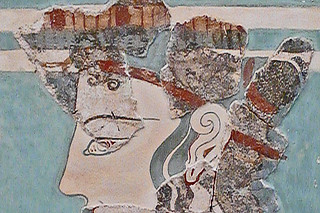
Below is the Kouros which is a type of statue that was part of the Archaic sculpture of ancient Greece around 7th century BC. As the Greek culture developed, the sculptures also became more realistic and the proportions more natural.
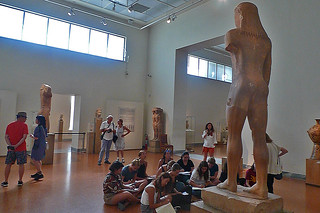
This statue is called the Artemision Bronze and is believed to be either Zeus or Poseidon. It can be found in the Classical section of the museum. This was unearthed in the sea of Cape Artemision from a ship wreck that happened in the ancient times. The statue may be holding a thunderbolt or a trident but no one knows.
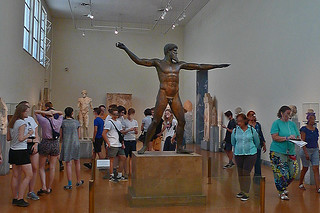
The statuette in the middle is called the Athena Varvakeion. This is the 'truest and best preserved' copy of the most famous 40 foot statue of Athena Parthenos that once stood inside the Parthenon. The original sculpture was made by Pheidias in 438 BC. This small statuette copy was made during the Roman period 3rd century AD.

These wall fragments of boxers and antelope were part of frescoes that decorated the ancient houses of the Minoan civilization in the island of Santorini. Later in our trip to Santorini, we would learn more about the ancient Minoan civilization and Aegean archeology from our visit to the ruins of Akrotiri.

This bronze statue of Poseidon was unearthed from the sea of Livadostra (ancient Creusis, port of Plateaea) about 480 BC. This is part of the display at the Odysseys exhibition of the museum.
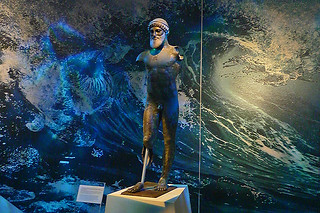
We found this very good coffee place called Island coffee while we were walking from the museum back to Ominou station.

From the Syntagma station, we walked through the pretty and relaxing National Garden to get to the Panathenaic Stadium.
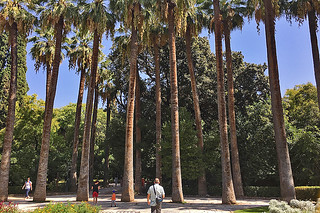
The sun was upon us but we didn't care. We walked the length of the Panathenaic Stadium (or Kallimarmaro) and up and down the seating areas. The entire stadium is made entirely of marbles. The marble seats are cool to the touch. The original stadium was build in 330 BC for the Panathenaic games and then rebuilt in marble by Herodes Atticus in 144 AD. The 1896 Olympics was held in this stadium.

As a refuge from the oppressive heat, Mijo and I decided to go to the Stadium museum where it was cool and where we saw lots of Olympic memorabilia from the olden days to the modern times. I enjoyed looking at the different Olympic posters and how the styles changed through the years.
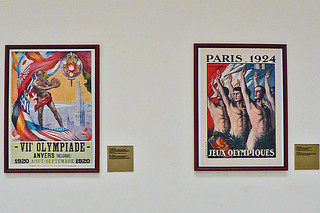
Near our hotel, we had a quick dinner at the Bread Factory. They serve the usual Greek fare and Greek sweets. We also saw an okra dish for the first time. We ordered the filled peppers and the okra dish. They were good.
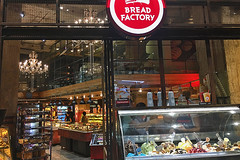
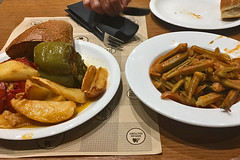
I'm truly glad that Mijo and I extended our stay in the city. I not only immensely enjoyed history, I met many local Athenians and heard their pride and joys and their struggles and challenges especially economically as part of the EU.
I do see myself traveling back to Athens for more history and stories. I hope I'll get another opportunity in the future.
Our next stop is the islands.
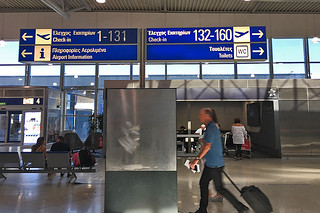
~rl


No comments:
Post a Comment